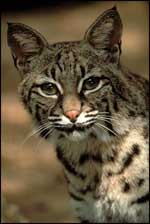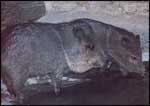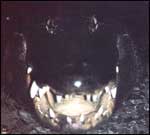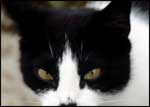Eyeshine

Animals that display the brightest eyeshine, such as the bobcat, have more rods (light receptors) and fewer cones (color receptors) in their retinas than animals with no eyeshine. As a result, they have excellent night vision, but most are color-blind.
Until primitive man discovered fire, making it possible for him to light up the night, he probably was unaware that certain animals have eyes that seem to glow in the dark. Imagine how frightened he must have been the first time he looked beyond the comforting circle of his campfire light to see a pair of shining eyes watching him from the darkness. With his limited knowledge, he didn’t know the glowing eyes were the result of reflected light—not the work of demons or supernatural creatures.
Perhaps you shared his twinge of fear the first time you saw glowing eyes in the woods, especially if you were sitting around a campfire telling ghost stories or listening to those strange night noises that stir the imagination. Even though some of you may not have had the opportunity to see a wild animal’s eyes shine, you probably have caught a glimpse of this reflected glow in the eyes of a pet dog or cat.
Eyeshine occurs when light enters the eye, passes through the rods (light receptors) and cones (color receptors) of the retina (image surface), strikes a special membrane behind the retina, and is reflected back through the eye to the light source. This special mirrorlike membrane, called the tapetum (ta-PEA-tum), is not present in the human eye. We have dark-colored cells behind our retinas, which absorb light rather than reflect it.

The majority of animals displaying eyeshine also are nocturnal animals.
Most of the animals with eyeshine are night hunters, and their ability to use the available light twice, once on the way in and again on the way out, gives these nocturnal animals additional light to see by. The majority of these glowing eyes belong to mammals, but spiders, alligators, and bullfrogs are a few other creatures with reflecting eyes. Some night birds also have eyes that glow in the dark, but their eyes do not have a tapetum layer. Scientists are still trying to solve the mystery of their source of eyeshine.
An interesting sidelight is that animals with the brightest eyeshine generally have more rods and fewer cones in their retinas. As a result they have excellent night vision, but most are color-blind.
Eyeshine coloration varies from the glowing reddish orange of the alligator to the yellows and greens of the deer and cat families. Just what causes these color differences has not been documented.

Although eyes with eyeshine are said to glow in the dark, they actually do not glow – they reflect available light. Light enters the eye, passes through the retina, and strikes a mirrorlike membrane called the tapetum. The tapetum reflects the light back through the eye to the light source. Eyeshine coloration varies with the species, amount of light, and the direction from which the light strikes the eye. Alligator eyeshine may vary from a bright reddish orange to an iridescent pink.
Because eyeshine is directed back to the light source, you must be in the right spot to be able to see it, usually directly behind the light. To increase your chances for seeing eyeshine, watch the roadsides carefully when riding in a car at night. The headlights often are reflected in the eyes of animals by the sides of the road. While walking at night with a flashlight, shine it in an arc around you and try to catch its reflection in the eyes of night creatures just beyond its circle of light. At times dozens of spiders’ eyes will reflect from patches of tall grass. Notice the eyes of your pet dog or cat as it approaches a lighted patio area, and you may be at the right angle to see its eyes reflect.
Those of you who have a cooperative cat might like to try this experiment. On the back of a small hand mirror draw a one-quarter-inch circle. Remove the silver from the circle to form a peephole. Get as close to your cat’s eye as possible while looking through the peephole. The reflective side of the mirror should face the cat. Turn off all lights except for one small lamp located across the room from you or let a friend shine a small flashlight in your direction. Tilt and adjust the mirror until the light from the lamp or flashlight is reflected into the cat’s eye. Since the light striking the eye comes from the mirror, rays from the tapetum will be reflected back to the mirror. Through your peephole you should be able to see the red blood vessels of the retina against the sparkling surface of the tapetum.

Cat eyes vary from yellowish gold to bright green.
Information on eyeshine is very sketchy, but perhaps one day further research into the subject will reveal some of its secrets. In the meantime we can but wonder about eyeshine, another mystery of nature.
Ilo
Hiller
1983 Eyeshine.
Young
Naturalist. The
Louise Lindsey Merrick
Texas Environment Series,
No. 6, pp. 40-42. Texas
A&M University Press,
College Station.